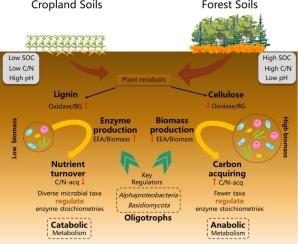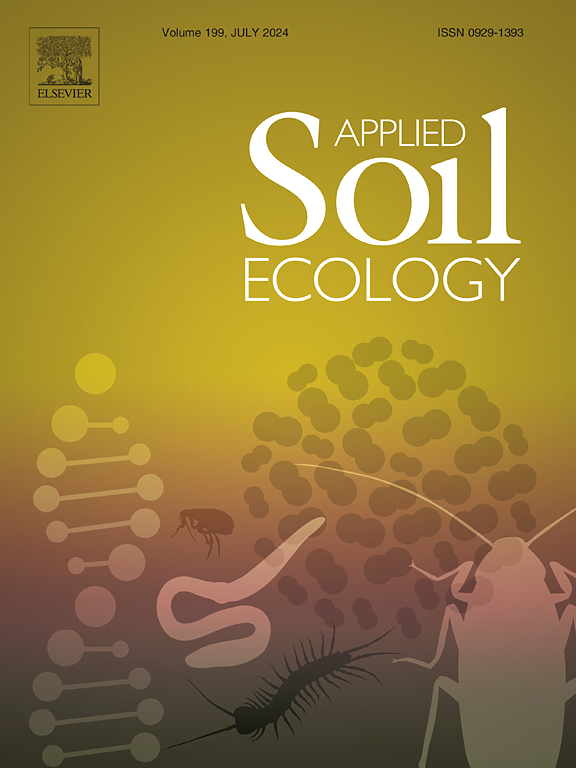生态型通过微生物资源分配塑造细胞外酶的化学计量学特性
IF 4.8
2区 农林科学
Q1 SOIL SCIENCE
引用次数: 0
摘要
微生物将资源分配给细胞外酶的生产,以便从复杂的有机物中获取限制性营养物质。然而,外酶化学计量(例如碳、氮和/或磷获取酶之间的比例)在自然生态系统和受管理的生态系统之间是否存在差异仍不清楚。因此,我们评估了古老森林土壤和耕地土壤中微生物群落组成、外酶化学结构和生活史策略(如共养生物和寡养生物)之间的关系。我们发现,耕地土壤与更丰富的共养类群、木质素降解以及更高的氮获取酶和氧化酶活性有关,而森林土壤则与更丰富的寡养类群、纤维素周转和更大的微生物生物量池有关。两个关键类群--担子菌群(Basidiomycota)和变形蛋白菌群(Alphaproteobacteria)在调节这两个生态系统的外酶化学计量方面发挥了重要作用。值得注意的是,共现网络分析表明,在受干扰的耕地土壤中,外酶化学结构与微生物生活史策略之间的关系要强于古老的森林土壤。基于这些结果,我们认为,在通过适应性管理措施保护森林土壤的同时,增加耕地土壤有机物质输入的数量和多样性,可以通过微生物循环加强碳流,促进土壤有机碳固存。将外酶化学计量学纳入基于性状的框架,可以进一步提高我们预测微生物群落结构变化如何扩大影响生态系统功能的能力。本文章由计算机程序翻译,如有差异,请以英文原文为准。

Ecotypes shape extracellular enzyme stoichiometries via microbial resource allocation
Microorganisms allocate resources toward extracellular enzyme production in order to acquire limiting nutrients from complex organic matter. However, it remains unclear whether exoenzymatic stoichiometries (e.g., ratios between carbon-, nitrogen-, and/or phosphorus-acquiring enzymes) vary between natural and managed ecosystems. Accordingly, we assessed relationships between microbial community composition, exoenzymatic stoichiometries, and life history strategies (e.g., copiotrophs versus oligotrophs) in old growth forest and cropland soils. We found that cropland soils were associated with more abundant copiotrophic taxa, lignin degradation, and higher activities of nitrogen-acquiring and oxidative enzymes, while forest soils were associated with more abundant oligotrophic taxa, cellulose turnover, and larger microbial biomass pools. Two keystone taxa, Basidiomycota and Alphaproteobacteria, played strong roles in regulating exoenzymatic stoichiometries across both ecosystems. Notably, co-occurrence network analysis suggested relationships between exoenzymatic stoichiometries and microbial life-history strategies were stronger in disturbed cropland soils than old growth forest soils. Based on these results, we suggest increasing the quantity and diversity of organic matter inputs to cropland soils, while protecting forest soils through adaptive management practices, could enhance carbon flows through the microbial loop and promote soil organic carbon sequestration. Incorporating exoenzymatic stoichiometries into trait-based frameworks could further improve our ability to predict how changes in microbial community structure scale up to influence ecosystem function.
求助全文
通过发布文献求助,成功后即可免费获取论文全文。
去求助
来源期刊

Applied Soil Ecology
农林科学-土壤科学
CiteScore
9.70
自引率
4.20%
发文量
363
审稿时长
5.3 months
期刊介绍:
Applied Soil Ecology addresses the role of soil organisms and their interactions in relation to: sustainability and productivity, nutrient cycling and other soil processes, the maintenance of soil functions, the impact of human activities on soil ecosystems and bio(techno)logical control of soil-inhabiting pests, diseases and weeds.
 求助内容:
求助内容: 应助结果提醒方式:
应助结果提醒方式:


